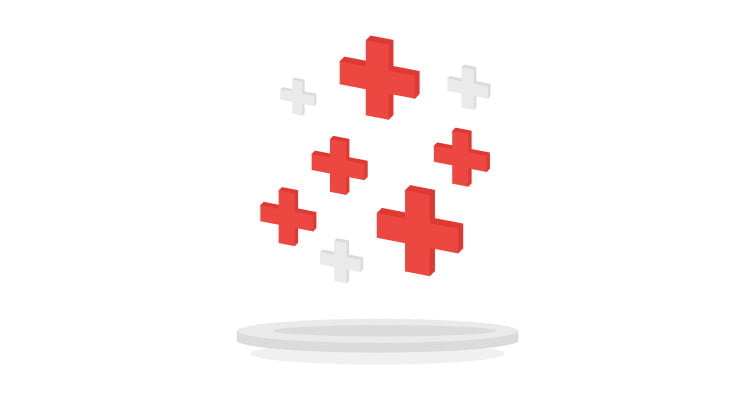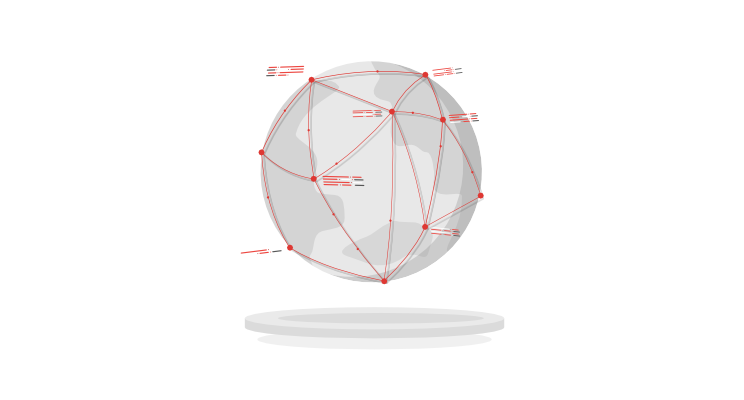
Big Data In Healthcare: Data Analytics That Saves Lives

How Covid-19 Showed Us The Importance Of Big Data In Medicine
Big Data and modern programming technologies have been indispensable for years, affecting almost every area of our lives – from commerce, finance marketing to aviation, and crime prevention. The biggest potential of Big Data and new technologies can be seen when it comes to reducing the costs of doing business, allowing faster access to information, and improving management.
The recent struggles with the global epidemic of COVID-19 show how great an impact new technologies can have, not only on safety, health, and human life – but literally on the future of humanity. Technology, combined with large data sets, has an influence not only on changes in the world of clinical research and medical care but also on strategic decisions relating to crisis management and ultimately the organization of a new socio-economic reality.
In this article, you will find many interesting examples of this. We hope they will inspire you to use the potential of Big Data and new technologies in your company, organization, or institution.
Technology and Medicine – an eternal alliance
Skin cancer
Does an advancement in the medical diagnosis of skin cancer sound like a milestone in saving human life? This can now be done by “IBM Watson Health” – a technology platform that uses natural language processing (NLP) and machine learning to view large amounts of unstructured data. In the language of technology – Big Data has made this possible.
IBM Watson can compare hundreds of thousands of medical photos to support medical diagnosis and adjust treatment options. It can also translate a patient’s DNA into a so-called genetic profile, which, combined with medical knowledge, helps doctors to personalize the cancer treatment process. A single human genome is approximately 750 MB of information. Its analysis, combined with the review of information from health records, patient tests, handbooks, and comparison of similar cases, would mean countless hours of a doctor’s time. Watson can perform such tasks in a few minutes, preparing a visualization of the patient’s individual case and suggesting appropriate treatment methods, based on the patient’s individual DNA profile.
Parkinson’s disease
Big Data has also given a new, positive outlook for people with Parkinson’s disease. On the initiative of actor Michael J. Fox and his foundation, patients are kept under constant observation thanks to the use of a special watch which measures their sleep time, balance disorders, or uneven gait (one of the symptoms of the disease). Analysis of data obtained this way helps support the fight against Parkinson’s disease.
Folding@home – a key project in the field of Medtech
A key project in the area of Big Data is the Folding@home project organized by Stanford University in the United States. The goal of the project is to investigate how a protein molecule is composed of space. The shape it can perform in the body depends on this shape. If there is any abnormal particle assembly, diseases such as CJD (Creutzfeldt-Jakob Disease), Alzheimer’s, and Parkinson’s disease or BSE (Bovine Spongiform Encephalopathy) can appear.
Folding@Home is one of the oldest distributed computing projects and is currently the largest in terms of computing power. Hundreds of thousands of personal computers all around the world are connected via the Internet to servers located at Stanford University. This network supports their computing power and enables Standford’s researchers to download data for their calculations. Scalac employees are proud to be contributing to this project by sharing their own computer power as well.
How Big Data is helping the fight against COVID-19
You may be wondering how these examples relate to the SARS-CoV2 virus epidemic. Below you will find some evidence of medical and engineering achievements that have been developed. Today – when the SARS-CoV2 virus has redefined the lives of people around the world, becoming a dangerous adversary – new technologies have become an invaluable ally in this fight.
Preventive measures and logistics
Big Data, AI, Machine Learning and Natural Language Processing – a kit for fighting COVID-19
The combination of artificial intelligence, machine learning, NLP, and modern programming languages (such as Scala) with large data sets is a recipe for fighting the virus in several key areas. From effective prevention and forecasting the spread of the virus up to faster and more accurate decision-making. It is also an opportunity to implement the right tools in the process of organizing people’s lives in an epidemiological situation. For example, providing regular information about a dynamically changing situation or making it easier for people to function in a new reality.
The aforementioned Folding @ home project has combined the use of data engineering before and after the COVID-19 epidemic. The Folding @ home project team took the challenge of testing the SARS-CoV-2 virus protein. Within just a few days, over 400,000 volunteers had shared their computers, providing a total computing power of 474 petaFLOPS. The overall system performance has become greater than the combined performance of the 103 most powerful supercomputers in the world.
Optimization of treatment; logistics and preventive measures
Crisis management takes on a completely different dimension if we can efficiently forecast the dynamics and extent of the virus. It can help us with both prevention and rescuing lives. Hospital logistics are made easier in terms of the availability of hospital beds, medicines, equipment such as respirators, or such necessary and limited goods as personal protective equipment (masks, gloves, disinfectants). Data analyzed in real-time also helps provide effective preparation and planning of activities in other locations that have not yet been affected by the virus.
Access to such data was used by Taiwanese officials, who were able to estimate the demand and supply of masks and isolation rooms in the region. Thanks to this information, they were able to properly prepare for the fight against SARS-CoV2.
Data in support of decision making
Another way new technologies and large data sets can be used is to create applications and solutions registering human mobility. These applications, in conjunction with devices and networks belonging to mobile operators, can effectively and quickly reveal networks of contacts between people and therefore the timeline of infections.
The work of scientists and engineers has produced interesting solutions, including “Epi-risk”, a predictive model that analyzes how the disease spreads from one city to another. The model depends on air travel and commuting patterns. The Event Horizon project works in a similar way. This solution uses a mathematical model that predicts where the virus can spread based on international flight routes.
Data and modeling the spread of the virus – an example from Taiwan and European countries
Taiwan was a pioneer in using Big Data solutions during the COVID-19 epidemic. They quickly mapped the virus spread model, which blocked further transmissions. How? Data from the Taiwanese National Health Insurance Database were linked to the Immigration and Customs Database. The travel history and symptoms of citizens were traced and the data was made available to hospitals, pharmacies, and other healthcare facilities on an ongoing basis. Based on this information, entry to Taiwan was closed to people from the most-threatened regions. People who crossed the border were also monitored on an ongoing basis. Similar monitoring was applied to quarantined residents.
These solutions were also used by European governments during the COVID-19 epidemic. They most often use cell location data provided by cellular network operators. For example, in Germany, to what extent the German population complied with restrictions – such as the order to stay at home – was analyzed.
The use of social media in the fight against COVID-19
If someone thought that social media is a worthless waste of time, they may now change their mind. Social media are an important source of Big Data due to the fact that users share a huge amount of data about themselves. Demographic and location data are particularly important and interesting. Thanks to access to such data and the work of engineers specializing in natural language processing, we can now use a Health map. This is an initiative of the Harvard Medical School, Boston Children’s Hospital, and Northeastern University, through which the COVID-19 spread model can be followed.
Diagnosis and medical science
Maximizing the acceleration of vaccine development
The area most scientists are now looking at very closely is that of biomedical research leading to vaccine development. They are also trying to find an optimal test method for COVID-19 as well as test out medicines that can fight COVID-19. This work is bringing us closer to understanding the nature of the virus by using the potential of large data sets, artificial intelligence, machine learning, and programming. Research projects may require molecular modeling. Scientists and IT engineers may try to map coronavirus data. They can do this by combining treatment history and average recovery time with data from pharmacological and genomic databases.
Efficient diagnosis and selection of social distancing strategies thanks to Big Data
Big Data also enables efficient decision making in the selection of social distancing solutions to be made. At UTHealth, a team developed an artificial intelligence tool, showing the need for more stringent, immediate intervention in the Greater Houston region, where residents were not complying with the restrictions.
Artificial intelligence is also being used to diagnose COVID-19 infection. “Infravision” is software that automatically detects COVID-19 related symptoms, using computed tomography images. It recognizes the changing characteristics of the disease, thereby accelerating diagnosis and reducing the risk of misdiagnosis. This solution is used by doctors from the College of Computer Science, Nankai University in China among others.
Meanwhile, at Stanford University, scientists have launched a data-based model that predicts the possible results of various intervention strategies for movement/distance restrictions.
Quick response – the secrets of Big Data and new technologies
What is the secret behind the effectiveness of these solutions? This is without a doubt the speed and time of reaction. A characteristic feature of the biological danger from COVID-19 is its rapid rate of spread. Data and information become out of date within just a few hours. This requires the use of solutions that enable real-time analysis, and it is here the alliance of Big Data and new technologies comes into its own. These technologies can analyze the latest data at the speed of light and eliminate false leads. It can bring us closer to the goal of having the most up-to-date information in the shortest possible time. Also, it can improve, for example, the development of a vaccine. Its speed has become the main strength of Big Data.
Technological aspects of using Big Data against COVID-19
Spark – the technology that tames large data sets
One of the most popular technologies used worldwide to subdue large amounts of data, is Spark, software supported by the Apache foundation. It’s written in a modern, functional programming language – Scala. Spark can not only effectively use every available processor core but can also synchronize the work of a lot of computers, increasing their computing power. It’s limited only by the number of available machines. You could potentially build a cluster of any size that can handle the processing of any amount of data (i.e., comparing hundreds of thousands of COVID-19 test results, or receiving signals from thousands of mobile devices of people in quarantine).
Scalac has specialized in technologies such as Scala and Spark for 6 years. We have used these technologies since the very beginning. We recommend them to clients from around the world and we have already had 89 satisfied companies. Functional languages such as Scala support the latest technologies.
Just a few years ago, the performance of computers used to increase by simply strengthening individual components. However, this has stopped being the best solution, due to the limitations of processor production technology. Engineers now decide to increase their capabilities by increasing the number of computers available to them instead of increasing the performance of any single core. After all, programming languages at that time were not able to cope with the development of multi-core software. This situation ultimately led to an increase in the popularity of functional languages such as Scala, allowing faster development of modern software that can use all of the benefits of multi-core processors. The author of this language is professor Martin Odersky -a professor from the École Polytechnique Fédérale de Lausanne and co-founder of the promoter company Lightbend.
Data visualization
Visualization is a procedure that allows you to optimize the process of analyzing large amounts of data. Visualization of data can greatly affect speed and effectiveness when it comes to medical and strategic decisions. Data without proper visualization can often be confusing and overwhelming. With the right visualization, you can easily identify relationships between data and respond accordingly. We recommend checking out one of many examples of a data visualization process – Analytical Dashboards implemented by Scalac consultants (https://scalac.io/services/analytical-dashboards/).
The role of open-source
Recently, a number of websites have been created through which researchers, engineers, and other interested people can track open data and documents. These have become vital to the work of finding solutions (not only technological) to fighting the virus. Here are some examples we recommend:
– World Health Organization data – WHO
– European Center for Disease Prevention and Control -ECDC data
– https://github.com/CSSEGISandData/COVID-19
– https://data.europa.eu/euodp/pl/data/dataset/covid-19-coronavirus-data
– https://covid19api.com/
– Amazon Web Services and Google Cloud both support current work in the field of free access to open data sets and analytical tools.
What Scalac has to offer when it comes to Big Data
Big Data is the future – this is indisputable. That is why for six years Scalac has been popularizing this technology to business representatives, institutions, and programmers. Most of the clients supported by Scalac are foreign, in large part from the United States. We have seen a growing interest in functional programming languages, including Scala, in other markets as well. Companies and institutions are beginning to pay attention to the possibilities of a functional approach, which can create miraculous opportunities – including the saving of human lives.
Sources
- https://scalac.io/services/analytical-dashboards
- https://www.ie.edu/business-school/news-and-events/whats-going-on/big-data-artificial-intelligence-can-help-covid-19
- https://www.thejakartapost.com/academia/2020/03/17/using-big-data-to-fight-pandemic.html
- https://www.bruegel.org/2020/03/big-data-versus-covid-19-opportunities-and-privacy-challenges/
- https://healthitanalytics.com/news/understanding-the-covid-19-pandemic-as-a-big-data-analytics-issue
- https://www.ie.edu/business-school/news-and-events/whats-going-on/big-data-artificial-intelligence-can-help-covid-19/
- https://itwiz.pl/jaki-sposob-big-data-moze-wesprzec-walke-epidemia-koronawirusa-covid-19/
- https://worldengineeringday.net/ai-big-data-infotech-deployed-against-covid-19/
- https://www.forbes.com/sites/ciocentral/2020/03/30/big-data-in-the-time-of-coronavirus-covid-19/#7df6f2f258fc
- https://spectrum.ieee.org/the-human-os/biomedical/devices/big-data-helps-taiwan-fight-coronavirus
- https://poland-today.pl/polish-big-data-company-forecasts-covid-19-peak/
Read more











